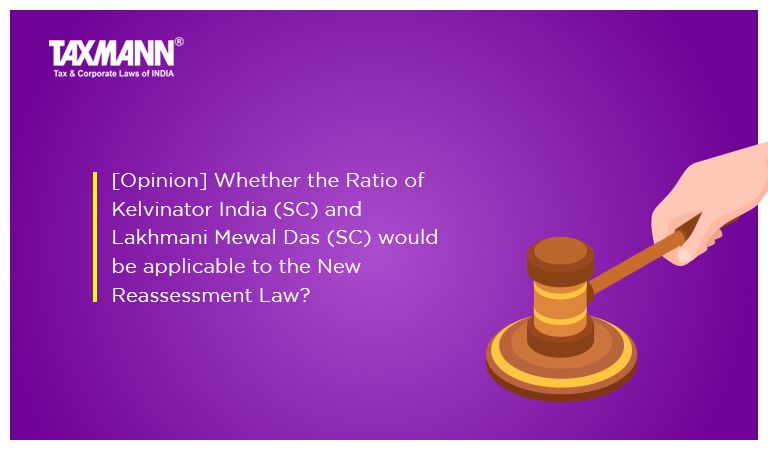[Opinion] Whether the Ratio of Kelvinator India (SC) and Lakhmani Mewal Das (SC) would be applicable to the New Reassessment Law?
- Blog|News|Income Tax|
- 3 Min Read
- By Taxmann
- |
- Last Updated on 26 September, 2022
Shikhar Garg – [2022] 142 taxmann.com 416 (Article)
Introduction
The Reassessment Law under the Income tax Act was always a draconian weapon under the armory of the Income tax Department. Once an assessment is concludes, it reaches ad infirmity, unless there is a dispute. As a general rule, the altercation in the assessment is concluded by the higher authority. In case of disagreement from the department side, Commissioner of Income Tax (CIT) can invoke power u/s 263 of the Act. In case of discourse from assessee side based on question of facts, The Appellant can appeal in Appellant Forums i.e., Commissioner of Income tax appeal CIT(A) u/s 246A or in some cases directly in Income Tax Appellate Tribunal (ITAT) u/s 253.
The Reassessment law is a combination of substantive as well procedural provision under the Act, which provides that the “same authority” (Not higher authority) who has concluded the assessment to reanimate the assessment. The provisions are exception to the general rule, that is why, this procedural law (Machinery provisions) cannot be interpretated liberally. The reassessment law is a power of extraordinary in nature, the provisions of this law should be read in strict manner. Moreover, since the provisions are specifically for the help of revenue and not for the assessee, all the requirements of the sections should be given due and equal weightage. The courts have provided some Nomen juris that are Reason to Review, Reason to suspect, Tangible material & Live Link formation regarding the reassessment procedures.
In this article, let us try to demystify that whether some of the ratio of the landmark judgements of Supreme Court namely CIT v. Kelvinator of India Ltd., ITO v. Lakhmani Mewal Das are still applicable to newly amended provisions of the reassessment law. The ratio of these judgements are yet to be seen that whether it holds water on the newly amended law, it is still a judicial enigma.
Legal Historical Background
The Reassessment procedures are more than century old provisions. Under section 25 of the Income Tax Act 1918, Income escaping assessment in any year were assessable in the following year. The collector were empowered to assess or re-assess income chargeable to tax has escaped assessment for any reason.
Under section 34 of the Income Tax Act 1922, provisions of income escaping assessment has been incorporated. The Income tax Officers empowers the reassessment procedures, provided with certain safeguards for the taxpayers. The reasons to satisfied for reopening the assessment must be in good faith and should not be mere pretence or inkling. There should be definite information that income chargeable to tax has escaped assessment.
In the year 1961, India was at a shadow war with China. Thereafter, in 1962, India was at frontal war with China and with Pakistan in 1965. During those turbulent times, Parliament enacted Income Tax Act 1961, wherein, a complete code was introduced for reassessment from Sections 147 to 153. Section 147 was considered as substantive provision, but it does not create any charge on the subject. It merely deals with making the whole machinery (Sections 148 to 153) workable.
With more than 65 judgments of supreme court and more than 2,500 judgements of various high courts across the country. The dockets of appellant authority (CIT(A) & ITAT) are totally cluttered with reassessment appeals. The income tax act 1961 has been amended several times via Finance act 1962, 1989, 2001, 2012, to be in consonance with the judicial pronouncements & changing requirements. Although the law was completely settled, but landmark judgment of supreme court GKN Driveshaft India Ltd. v. ITO, coupled with advancement of technology (Information driven system) led to the major revamp in reassessment procedure as amended in Finance Act 2021. As of now in the last 1.5 years of new law, The New scheme that is, progressive as well as futuristic scheme of reassessment, whose intent is laudatory, has in its implementation, not only been rendered nugatory but also had shown an unintended opposite result.
Click Here To Read The Full Article
Disclaimer: The content/information published on the website is only for general information of the user and shall not be construed as legal advice. While the Taxmann has exercised reasonable efforts to ensure the veracity of information/content published, Taxmann shall be under no liability in any manner whatsoever for incorrect information, if any.

Taxmann Publications has a dedicated in-house Research & Editorial Team. This team consists of a team of Chartered Accountants, Company Secretaries, and Lawyers. This team works under the guidance and supervision of editor-in-chief Mr Rakesh Bhargava.
The Research and Editorial Team is responsible for developing reliable and accurate content for the readers. The team follows the six-sigma approach to achieve the benchmark of zero error in its publications and research platforms. The team ensures that the following publication guidelines are thoroughly followed while developing the content:
- The statutory material is obtained only from the authorized and reliable sources
- All the latest developments in the judicial and legislative fields are covered
- Prepare the analytical write-ups on current, controversial, and important issues to help the readers to understand the concept and its implications
- Every content published by Taxmann is complete, accurate and lucid
- All evidence-based statements are supported with proper reference to Section, Circular No., Notification No. or citations
- The golden rules of grammar, style and consistency are thoroughly followed
- Font and size that’s easy to read and remain consistent across all imprint and digital publications are applied






 CA | CS | CMA
CA | CS | CMA


